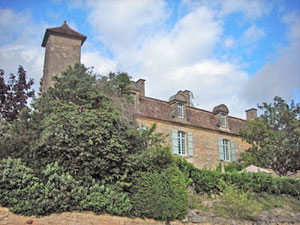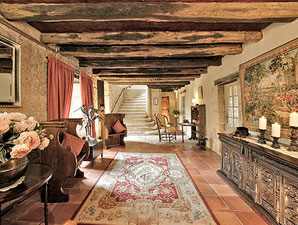 |
| The Independent Traveler's Newsletter PAGE FOUR |
 |
| The Independent Traveler's Newsletter PAGE FOUR |
| FEATURING: FALL IN LOVE ~ with these French Villages Part I in the series | |
|
The day we pick up our rental car in France is the same day that our adventure begins. As lovely, comfortable and convenient as it is to take a train from Paris to another city or town, that rental car allows us the freedom to explore and discover France on our own. Whether the car has GPS or not matters little to us, as we have our trusty and reliable Michelin Motoring Atlas to show us the way - from the tiniest roads to châteaus, archaeological sites, monuments, parks, churches, cycle paths, golf courses, lighthouses, airports, railway stations, and even speed cameras! Michelin maps reveal them all. But, beyond our new-found power to take charge of our time in France, we have that sense of expectation about what we will find around the next turn in the road. Although we love the scenery, we are most captivated by small, charming villages - many on hilltops overlooking wide expanses of undulating meadows - where we can wander the cobbled lanes and absorb, in many cases, the Medieval history that surrounds us. In this issue, we will visit two of our favorite French villages - ones that we have visited (each more than once) because they are wonderful places to be. Our time there took our minds away from everywhere else for a few days - we had fallen in love with 'our' villages! LAUTREC
The tiny Medieval village of Lautrec in the Tarn département of the Midi-Pyrénées region is truly special. Its history goes back to Charlemagne who, legend has it, laid the foundations of a church at the bottom of what became the rampart walls. It was called Saint-Rémi as it was beside a spring of that name, but because it was outside the town walls, it was allowed to deteriorate over time. But the rampart walls are still strong and remind one of the history of this compact and cozy village. It is also the birthplace of the ancestors of Henri Toulouse-Lautrec who himself was born in nearby Albi. He went off to Paris and never visited the village of Lautrec! One of the unique offerings in Lautrec is pink garlic (l'ail rose). It is grown near the village and is known throughout France for being the most pungent of varieties. During our visit last year we met several tourists who were there just to buy the garlic - but then happily discovered the village's charms. Two couples were traveling in motor homes and had detoured well out of their way to buy garlic. The others were two Scotsmen who thought nothing of driving over two and a half hours that morning to come to Lautrec to buy l'ail rose. Of course, we bought a few bunches of it ourselves - couldn't leave Lautrec without it!
During
our last visit we strolled throughout the village, as we had done in years
past, but this time more deliberately to take in the architectural features
of the stone houses, resplendent with flower boxes and brightly colored
front doors. Little signs, some clever and some humorous, caught
our attention. We enjoyed walking the perimeter of the village on
the road that comes up from the valley below and snakes its way around
to the top outside the ramparts. On Sunday we attended Mass in the
14th century Collégiale Church of Sainte-Rémy, a listed
Historic Monument and a landmark of the village.
The history of the church goes back to 1394 when it was built as Eglise Sainte-Marie de la Paix. The construction was made possible by two citizens of Lautrec. Further expansion took place in 1521 and 1625, upgrading the modest church to a collégiale church and it was renamed Collégiale Saint-Rémy. The church vault dating to 1768 was decorated with trompe l'oeil artwork by Jacques Pauthe in 1852 and was restored in the 1990s. Lautrec is one of the Plus Beaux Villages de France - one of the Most Beautiful Villages of France - a designation that is hard to come by. A rural village must meet 30 criteria to be accepted. Three specific requirements will disqualify it if not met: it must have a maximum population of 2000 inhabitants, must have at least two protected sites or monuments, and must have proof of mass support for the planned application for membership by furnishing the decision voted by the Town Council. At this time France has only 156 villages in 21 regions and 69 départements. The Association wants each village to retain its character and protect its heritage and not become a 'theme park' of sorts. Lautrec definitely meets all the qualifications. Located only thirty kilometers from Albi (where the Toulouse-Lautrec museum is located) and less than an hour from the city of Toulouse, Lautrec's name is derived from the Occitan word l'autreg, which suggests that at one time people paid a tax when passing or entering the village. It has a strategic position as it is sheltered by the rocky hill Colline de la Salette. The ramparts from the 13th century and one of the original eight gates, Porte de la Caussade, remain. It also has a covered market in the town square: Place des Halles. In addition to several shops selling pink garlic, there is a clogmaker's workshop (one of its historic monuments) and the very interesting Office de Tourisme which displays an ancient convent bake oven and a model of the village showing the changes to the village over the centuries.
Last but not least, is the village windmill atop Salette Hill, built in the 17th century on the foundations of a mill dating from 1396. In 1991 it was completely restored and is the only working mill in the region.
We hope that you will visit Lautrec and spend a few days there. A new café just opened in 2011, and the town square, Place du Monument, shown in this photo will see some improvements - but we hope they never paint over that incredible Dubonnet 'mural'! Oh, about the amusing signs we saw while wandering around the village . . . here are two:
Where to stay in Lautrec:
BIRON
The commune of Biron in the département of the Dordogne (specifically the Black Périgord) is a delightful place to spend time while in France. Its massive château can be seen from miles away and is open to both guided and self-guided visits. We find Biron the perfect spot to stay in the Dordogne - easy to reach and convenient to so many area attractions.
Classified as an Historic Monument, the castle changed hands often between English and French and was owned by fourteen generations of the Gontaut-Biron family until the State took it over in the 20th century. It has historical ties to the nearby fortified market town of Monpazier built in 1284. Once inside, visitors can see the 12th century dungeon, a two-story chapel, Renaissance apartments, impressive vaulted kitchens and more.
Biron
is simply delightful and lies within the outer walls of the castle.
Its proximity to Monpazier (market day shown in this photo), Trémolat,
Domme, Sarlat, Beynac-et-Cazenac, La Roque Gageac, Bergerac, Les Eyzies-de-Tayac
and the Grotte de Lascaux make it the ideal place to stay. We've
spent several days there on more than one occasion, and we have enjoyed
the peace and tranquility, walks through the tiny lanes, and the sunset
views in the evenings which are spectacular. During our last visit
we had the first-time experience of hearing, late at night, the deep roaring
sounds of a mature buck deer - it was rutting season.
A highlight of Biron is the priory. Today it is a beautiful bed and breakfast accommodation whose history is worth noting. The southwest wall of the Le Prieuré was part of the fortification of the village of Biron dating back to the 12th century and is over one meter thick. The priors who moved into the building added large Renaissance style windows to let in sun and light. In 1779, a new wing was added comprising the stables on the ground floor and an apartment on the first floor, and this addition created a small courtyard in front of the house. The tower of the Prieuré is thought to be the last of several that existed along the perimeter of the original defensive walls of the village. Le Prieuré was a working monastery, and the large brick bread oven was most likely the village bread oven for awhile.   Ownership of Le Prieuré over the years is uncertain, but it was in the aforementioned Gontaut-Biron family from the twelfth to the twentieth centuries as was the castle. In recent years it changed owners several times to now become the much-loved home to its dedicated French owner, Elisabeth Vedier, who has completed many upgrades and renovations to make every room perfect. Biron may not offer the hustle and bustle of larger towns, but its charming winding lanes, interesting houses, and serene location is an excellent home base for anyone who wants to explore this part of the Dordogne and return each evening to a peaceful and beautiful village. Where to stay in Biron:
[Please mouse over photos for descriptions and credits.] |
|
|
|